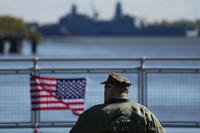The percentage of women in the military who were sexually assaulted in 2021 spiked to the highest level since the Defense Department started tracking the statistic more than a decade ago, according to new data released Thursday.
About 8.4% of female troops and 1.5% of male troops said they were assaulted while on duty during the past calendar year, the department's annual 2021 report shows based on surveys of service members. That is about 35,900 total service members, compared to the previous high of 34,200 in 2006, when 6.8% of women were estimated to have been assaulted.
The number of sexual assault reports filed by victims with military authorities -- the other key metric used by the department to gauge the scope of the problem -- also jumped about 15% from the previous year, from 6,290 to 7,260 cases.
Read Next: VA Accelerates Toxic Exposure Claims, Urges Veterans to Apply Now
Even after years of high sexual assault rates, the newest findings on the active-duty military were bleak, and the increases in assaults were also accompanied by plummeting confidence among female and male troops alike that the military can protect them and treat them fairly, the research found. The department called the figures a new "baseline," but also said the overall prevalence rates, which are derived from surveys, cannot be scientifically compared to past years due to government-ordered changes in how sex assaults are measured.
"These numbers are tragic and extremely disappointing. On an individual level, it is devastating to conceptualize that these numbers mean that over 35,000 service members' lives and careers were irrevocably changed by these crimes," Beth Foster, the executive director of the Pentagon's Office of Force Resiliency, said during a briefing to reporters Thursday. "These events not only have an impact at an individual level, but they also degrade our readiness and ability for the department to conduct our mission."
Defense Secretary Lloyd Austin plans to hire a group of new full-time, specialized professionals tasked with preventing the assaults, which was among the recommendations of an independent commission he created to review the problem last year. Congress has also ordered an overhaul of military justice handling of the cases, but neither change has yet fully taken effect.
Andra Tharp, the senior prevention adviser with the Office of Force Resiliency, said the Pentagon has been "sprinting" to begin setting up the new system of specialized personnel.
"We're doing targeted outreach to ensure we get the right talent in these critical positions," said Tharp, who also briefed reporters. "And over the past several months, the department has initiated hiring the first 400 of these prevention professionals and will continue hiring over 2,000 in the coming years."
The full implementation of the department's new sexual assault prevention measures won't be completed until 2027, Deputy Secretary Kathleen Hicks said when the effort was unveiled last year.
Lawmakers passed an annual defense policy bill last year that creates independent prosecutors to handle sexual assault and other serious crimes within the Uniform Code of Military Justice, out of frustration that the military can't handle the problem.
"The adjustment in how the data is gathered appears to confirm what survivors and advocates have been saying for years: The reality is far more grim than the report numbers have suggested," Rep. Jackie Speier, D-Calif., chair of the House Armed Services Committee personnel panel, said in a press release issued Thursday.
Speier said she intends to hold a hearing on the report findings.
The overall percentage of troops who have been assaulted was reported for the first time since 2018 due to the pandemic, and the survey results show significant upticks using the new metric.
The Army, Navy and Marine Corps had an across-the-board increase of nearly 3% in the number of female service members who said they were assaulted. The Air Force showed a 1.2% increase, according to summary slides provided by department researchers.
Instances of male sexual assault -- although lower as a percentage -- doubled across all the services to between 1% and 2%. In the Army, a total of 5,884 men responded that they had been sexually assaulted, the highest total number compared to the smaller service branches. The Navy had the highest percentage of assaults among men, with 2.1% reporting that they were victims.
"This year is the second highest prevalence rate for men; the highest was in 2006," Foster said.
Meanwhile, the number of reported sexual assaults has continued to climb since 2009 -- a number that is separate from the survey results.
The Pentagon has argued the trend is positive because it indicates more victims feel comfortable filing the reports. But it has also caused an outcry from advocates and lawmakers who see an epidemic of assaults that appears to be unaffected by years of efforts at reductions.
The new report shows that reporting has spiked while trust in the military justice system has dramatically fallen among women and men.
About 69% of female troops said in 2018 that they trusted the military to ensure their safety following a sexual assault. That number dropped off to just 40% in 2021. When asked whether the military system would treat them with dignity and respect, the number of women who agreed or strongly agreed fell from 66% to 39%.
Men also reported being much more skeptical. The number who reported trusting the military to keep them safe fell from 84% to 64%. On the question of treatment with dignity and respect, the number of male troops who answered positively dropped from 82% to 63%.
-- Travis Tritten can be reached at travis.tritten@military.com. Follow him on Twitter @Travis_Tritten.
Related: Pentagon's First Wave of Sexual Assault Reforms Will Take 6 Years to Complete













